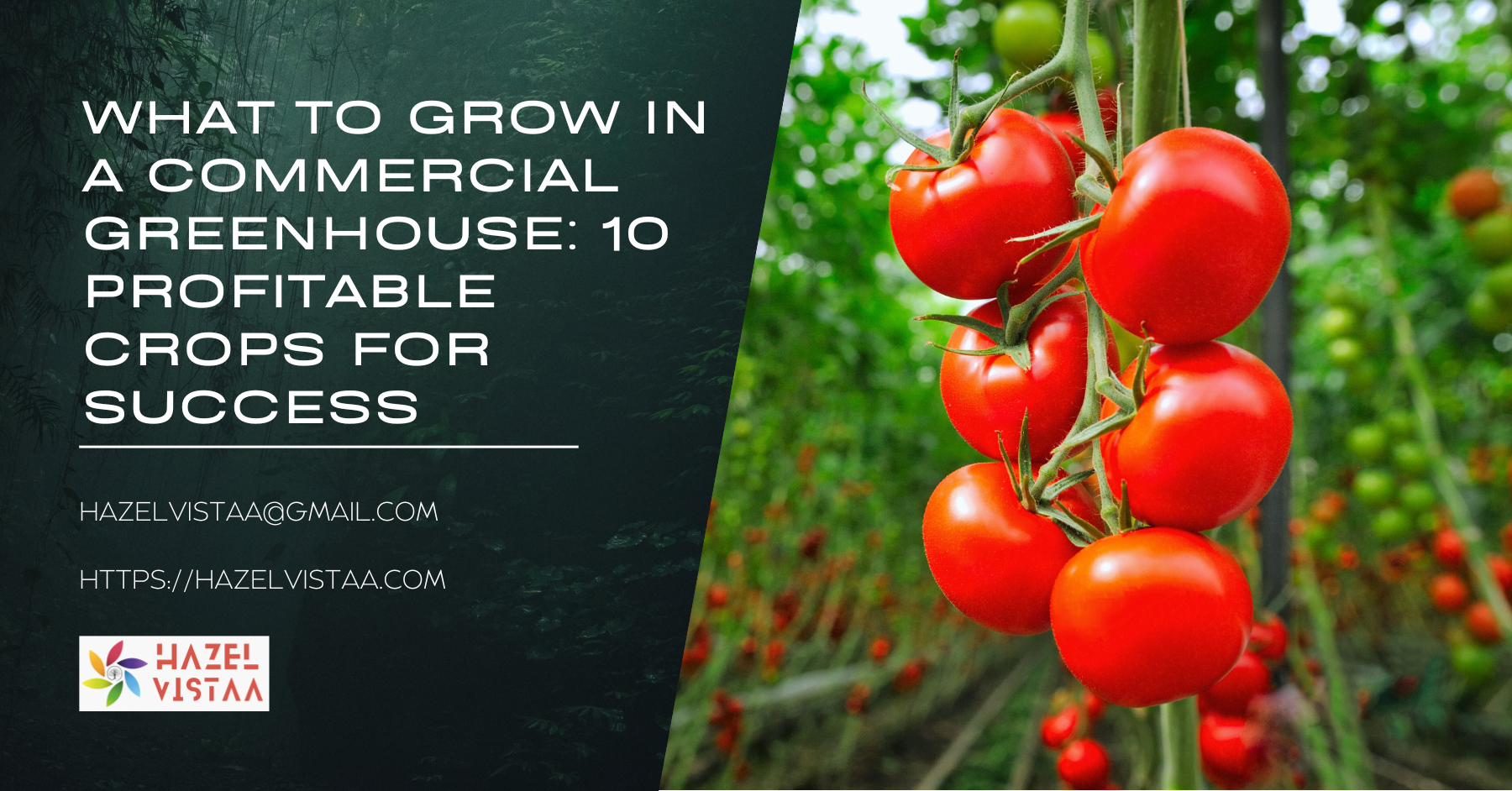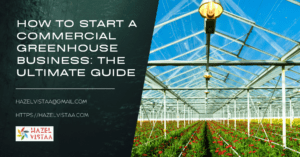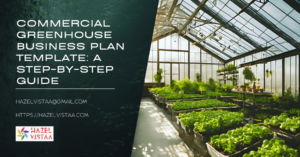Discover what to grow in a commercial greenhouse for maximum profit. Explore 10 lucrative crops, expert tips, and market insights to boost your greenhouse business success.
What to Grow in a Commercial Greenhouse?
When deciding what to grow in a commercial greenhouse, consider these top 10 profitable crops:
- Tomatoes
- Leafy greens (lettuce, spinach, kale)
- Herbs (basil, cilantro, mint)
- Cucumbers
- Bell peppers
- Microgreens
- Strawberries
- Cut flowers
- Specialty mushrooms
- Cannabis (where legal)
Choose crops based on market demand, climate control requirements, growth cycle, and profit margins. Factors like local competition, your expertise, and initial investment should also influence your decision. For best results, diversify your crop selection and stay adaptable to market trends.
Introduction
Ever stood in your empty greenhouse, scratching your head about what to grow? Trust me, I’ve been there! When I first started my commercial greenhouse venture, I was overwhelmed by the possibilities. But after years of trial and error (and a few spectacular failures), I’ve learned a thing or two about choosing the right crops. Today, I’m sharing my hard-earned wisdom to help you make smart choices for your greenhouse business.
Selecting the right crops can make or break your commercial greenhouse operation. It’s not just about what grows well – it’s about what sells well too. From juicy tomatoes to aromatic herbs, the options are endless. But don’t worry, I’ve got your back! We’ll explore the most profitable crops that have turned my greenhouse from a money pit into a thriving business.
Ready to turn your greenhouse into a green-making machine? Let’s dive into the world of commercial greenhouse crops and uncover the secrets to success!
| Key Takeaways |
|---|
| 1. Understand market demand and profitability factors |
| 2. Explore top 10 profitable crops for commercial greenhouses |
| 3. Learn about climate control and space optimization techniques |
| 4. Discover tips for maximizing yield and profit margins |
| 5. Gain insights on overcoming common greenhouse challenges |
| 6. Stay ahead with future trends in greenhouse farming |
Whether you’re a seasoned greenhouse guru or just starting out, this guide will help you navigate the lush landscape of commercial greenhouse crops. So grab your gardening gloves, and let’s get growing!
Factors to Consider When Choosing What to Grow in a Commercial Greenhouse
Before we dive into specific crops, let’s talk about the crucial factors that should guide your decision. Choosing the right crops for your commercial greenhouse isn’t just about personal preference; it’s about making smart, profitable choices.
- Market Demand: What do people in your area want to buy? Is there a gap in the market you can fill?
- Profit Margins: Some crops might be popular, but are they profitable? Consider the cost of production versus potential selling price.
- Growing Conditions: What can your greenhouse support? Think about temperature control, humidity, and lighting requirements.
- Space Efficiency: How much space does each crop need? Can you maximize your greenhouse space with vertical growing?
- Growth Cycle: How quickly can you turn around crops? Faster-growing plants might mean more frequent harvests and sales.
- Your Expertise: What are you good at growing? Don’t underestimate the value of your green thumb!
- Initial Investment: Some crops require more upfront costs for specialized equipment or seeds.
- Labor Requirements: How much time and manpower will each crop need?
Let’s break this down into a handy comparison table:
| Factor | High Impact Crops | Low Impact Crops |
|---|---|---|
| Market Demand | Tomatoes, Leafy Greens | Exotic Fruits |
| Profit Margins | Herbs, Microgreens | Basic Root Vegetables |
| Growing Conditions | Peppers, Cucumbers | Cold-weather Crops |
| Space Efficiency | Vertical Growers (Tomatoes, Cucumbers) | Sprawling Plants (Squash) |
| Growth Cycle | Lettuce, Microgreens | Long-season Fruits |
| Expertise Required | Specialty Mushrooms, Cannabis | Common Vegetables |
| Initial Investment | Hydroponic Systems | Traditional Soil-based |
| Labor Intensity | Hand-picked Fruits | Automated-harvest Crops |
Remember, the perfect crop for your commercial greenhouse is at the sweet spot where these factors align. It’s not just about what grows well, but what grows profitably in your unique situation.
In my early days, I made the mistake of growing what I loved to eat, not what the market wanted to buy. Let’s just say I ended up with a lot of eggplants and not a lot of profit! Learn from my mistakes and consider all these factors before you plant your first seed.
Top 10 Profitable Crops to Grow in a Commercial Greenhouse
Now that we’ve covered the factors to consider, let’s dig into the juicy stuff – the crops that can turn your greenhouse into a money-making machine. These are the stars of the show in my greenhouse, and they might just become yours too!
- Tomatoes: The king of greenhouse crops. They’re in high demand year-round and come in various varieties.
- Leafy Greens: Think lettuce, spinach, and kale. They’re quick to grow and always in demand.
- Herbs: Basil, cilantro, mint – these aromatic plants pack a profitable punch in a small space.
- Cucumbers: Great for vertical growing and always popular in the market.
- Bell Peppers: Colorful, versatile, and high-value crops.
- Microgreens: These tiny greens offer big profits and quick turnaround.
- Strawberries: A sweet addition to any greenhouse, especially if you can offer them off-season.
- Cut Flowers: Add some blooming profits to your greenhouse mix.
- Specialty Mushrooms: A unique niche that can set you apart from the competition.
- Cannabis (where legal): A high-value crop with growing demand in many areas.
Let’s break these down in a handy comparison table:
| Crop | Profit Potential | Growth Cycle | Space Efficiency | Market Demand |
|---|---|---|---|---|
| Tomatoes | High | Medium | High (vertical) | Very High |
| Leafy Greens | Medium-High | Short | High | High |
| Herbs | High | Short-Medium | Very High | High |
| Cucumbers | Medium-High | Medium | High (vertical) | High |
| Bell Peppers | High | Medium-Long | Medium | High |
| Microgreens | Very High | Very Short | Very High | Medium-High |
| Strawberries | High | Medium | Medium (can be vertical) | High |
| Cut Flowers | High | Varies | Medium | Medium-High |
| Specialty Mushrooms | High | Short-Medium | High | Medium |
| Cannabis (where legal) | Very High | Medium-Long | Medium | High (where legal) |
Now, let me share a quick story. When I first started, I went all-in on tomatoes. Boy, was that a rollercoaster! I learned that while tomatoes are profitable, diversification is key. Now, I always have a mix of quick-turnaround crops (like lettuce and microgreens) alongside my longer-term investments (like tomatoes and peppers).
Remember, the best greenhouse is a diverse greenhouse. Don’t put all your seeds in one pot, so to speak. Mix it up, experiment, and find the combination that works best for your market and your green thumb.
In the next sections, we’ll dive deeper into each of these crops, exploring the nitty-gritty of how to grow them successfully in your commercial greenhouse. Get ready to get your hands dirty (metaphorically, of course – we’re in a clean greenhouse, after all)!
Maximising Yield and Profit in Your Commercial Greenhouse
Alright, green thumbs, now that we’ve covered what to grow, let’s talk about how to grow it for maximum profit. After all, a greenhouse full of plants is great, but a greenhouse full of profitable plants is even better!
Here are my top tips for turning your greenhouse into a lean, green, profit-making machine:
- Optimize Your Space: Think vertically, not just horizontally. I once doubled my cucumber yield by implementing a vertical growing system. It was a game-changer!
- Implement Efficient Irrigation: A drip irrigation system can save water, reduce labor, and improve plant health. Trust me, your plants (and your wallet) will thank you.
- Master Climate Control: Invest in good temperature and humidity control systems. I learned this the hard way after losing a crop of tomatoes to a heatwave.
- Practice Integrated Pest Management (IPM): Don’t wait for pests to appear. Be proactive! A good IPM program can save your crops and your profits.
- Invest in High-Quality Growing Media: Whether you’re using soil or going hydroponic, don’t skimp here. Good media = good growth = good profits.
- Implement Crop Rotation: This helps prevent disease and maintains soil health. Plus, it keeps things interesting!
- Extend Your Growing Season: Use your greenhouse to its full potential. Year-round production can significantly boost your bottom line.
- Optimize Plant Nutrition: Get your fertilizer game on point. Too little, and your plants suffer. Too much, and you’re literally throwing money away.
Here’s a quick breakdown of how these strategies improved my greenhouse profitability:
| Strategy | Impact on Yield | Impact on Profit | Initial Investment |
|---|---|---|---|
| Vertical Growing | +40-60% | +30-50% | Medium |
| Drip Irrigation | +20-30% | +15-25% | Low-Medium |
| Climate Control | +30-50% | +25-40% | High |
| IPM | -10-20% crop loss | +10-20% | Low |
| Quality Growing Media | +15-25% | +10-20% | Low |
| Crop Rotation | +10-20% | +5-15% | Low |
| Year-Round Production | +50-100% | +40-80% | Medium-High |
| Optimized Nutrition | +20-30% | +15-25% | Low |
Remember, these aren’t just theoretical numbers. These are real results from my own greenhouse journey. Your mileage may vary, but the principles remain the same.
One last piece of advice: don’t be afraid to experiment. Some of my best innovations came from trying new things. Like the time I tried interplanting basil with my tomatoes. Not only did it maximize space, but the basil also acted as a natural pest repellent. Talk about a win-win!
In the next section, we’ll dive into some common challenges you might face in your commercial greenhouse journey, and how to overcome them. Because let’s face it, even in a controlled environment like a greenhouse, Mother Nature sometimes likes to throw us a curveball!
Common Challenges in Commercial Greenhouse Growing and How to Overcome Them
Let’s face it, growing in a commercial greenhouse isn’t always sunshine and roses (even if you’re actually growing roses). Over the years, I’ve faced my fair share of challenges. But don’t worry, I’m here to share my hard-earned wisdom so you can avoid the pitfalls and fast-track your success.
1. Pest and Disease Management
The Challenge: Pests and diseases can spread like wildfire in a greenhouse environment.
The Solution: Implement a robust Integrated Pest Management (IPM) program. This includes:
- Regular plant inspections
- Using beneficial insects
- Maintaining proper sanitation
- Implementing quarantine procedures for new plants
Pro Tip: I once lost half my tomato crop to spider mites before I got serious about IPM. Don’t make my mistake!
2. Climate Control Issues
The Challenge: Maintaining optimal temperature and humidity can be tricky and energy-intensive.
The Solution:
- Invest in a good climate control system
- Use shade cloths in summer and insulation in winter
- Consider energy-efficient options like geothermal heating/cooling
3. High Energy Costs
The Challenge: Greenhouse operations can be energy hogs, eating into your profits.
The Solution:
- Implement energy-efficient technologies (LED lights, energy curtains)
- Consider renewable energy sources (solar panels worked wonders for my operation)
- Optimize your growing schedule to take advantage of natural light and heat
4. Labor Management
The Challenge: Finding and managing skilled labor can be difficult and expensive.
The Solution:
- Automate where possible (irrigation, climate control)
- Implement efficient workflows
- Provide thorough training and create a positive work environment
5. Market Fluctuations
The Challenge: Prices can vary widely based on supply and demand.
The Solution:
- Diversify your crop selection
- Build strong relationships with buyers
- Consider value-added products (I started making basil pesto when I had a basil surplus – it was a hit!)
Here’s a quick rundown of these challenges and their potential impact:
| Challenge | Potential Impact | Difficulty to Solve | Long-term Benefit of Solving |
|---|---|---|---|
| Pest/Disease | High | Medium | Very High |
| Climate Control | Medium-High | Medium-High | High |
| Energy Costs | High | Medium | High |
| Labor Management | Medium-High | Medium | High |
| Market Fluctuations | Medium-High | High | Medium-High |
Remember, every challenge is an opportunity in disguise. When I first faced these issues, they seemed overwhelming. But tackling each one made my operation stronger and more profitable in the long run.
In our final section, we’ll look at some exciting trends and future prospects in commercial greenhouse growing. Because in this business, staying ahead of the curve isn’t just smart – it’s essential for long-term success!
Future Trends and Opportunities in Commercial Greenhouse Growing
As we wrap up our greenhouse journey, let’s gaze into the crystal ball (or should I say, the polycarbonate panel?) and explore some exciting trends that are shaping the future of commercial greenhouse growing. Trust me, staying ahead of these trends can give you a major competitive edge!
1. Sustainable and Organic Production
The Trend: Consumers are increasingly demanding sustainably grown, organic produce.
The Opportunity: Consider transitioning part or all of your greenhouse to organic production. It’s a challenge, but the premium prices can make it worthwhile. I made the switch with my herb section and saw my profits bloom!
2. Vertical Farming and Space Optimization
The Trend: As land becomes scarcer, the industry is moving upwards.
The Opportunity: Implement vertical growing systems. They’re not just for leafy greens anymore – I’ve seen successful vertical systems for strawberries, peppers, and even dwarf fruit trees!
3. Smart Greenhouse Technology
The Trend: AI, IoT, and automation are revolutionizing greenhouse management.
The Opportunity: Invest in smart systems for climate control, irrigation, and crop monitoring. My smart irrigation system paid for itself in water savings within a year!
4. Alternative Energy Sources
The Trend: Greenhouses are embracing renewable energy to cut costs and reduce environmental impact.
The Opportunity: Consider solar panels, wind turbines, or geothermal systems. They’re not just good for the planet – they’re good for your bottom line too.
5. Direct-to-Consumer Sales
The Trend: More growers are bypassing traditional distribution channels to sell directly to consumers.
The Opportunity: Explore farmers markets, CSA programs, or even on-site sales. I started a small farm stand and was surprised by how quickly it became a significant revenue stream!
Trend Impact Analysis
Here’s a quick analysis of these trends and their potential impact on your greenhouse business:
| Trend | Potential Profit Impact | Implementation Difficulty | Consumer Demand |
|---|---|---|---|
| Organic Production | High | Medium-High | Very High |
| Vertical Farming | Medium-High | Medium | High |
| Smart Technology | High | Medium | N/A |
| Alternative Energy | Medium-High | High | Medium-High |
| Direct Sales | High | Low-Medium | High |
Remember: These trends aren’t just passing fads. They represent the future of our industry. Embracing them can help you stay competitive and profitable in the long run.
A Word of Caution
While these trends are exciting, don’t feel pressured to implement them all at once. When I first heard about vertical farming, I went all-in without proper planning. Let’s just say it was a steep learning curve! Start small, experiment, and scale up gradually.
As we conclude, I hope this guide has given you valuable insights into what to grow in your commercial greenhouse and how to grow it successfully. Remember, the key to success in this business is continuous learning and adaptation.
So, what are you waiting for? Get out there and start growing… your crops and your profits!
Conclusion: Growing Success in Your Commercial Greenhouse
As we wrap up our journey through the world of commercial greenhouse growing, let’s take a moment to reflect on the key points we’ve covered. Whether you’re a seasoned grower or just starting out, remember that success in this field is all about continuous learning, adaptation, and a bit of green-thumbed intuition.
Key Takeaways:
- Choose your crops wisely: Consider market demand, profitability, and your specific greenhouse conditions.
- Diversify your offerings: Don’t put all your seeds in one basket!
- Optimize your space: Think vertically and maximize every square foot.
- Embrace technology: From smart irrigation to AI-powered climate control, technology can be your best friend.
- Stay ahead of trends: Organic production, vertical farming, and direct-to-consumer sales are shaping the future of greenhouse growing.
Remember, what to grow in a commercial greenhouse isn’t just about picking the most profitable crops. It’s about creating a sustainable, efficient, and adaptable operation that can thrive in changing market conditions.
My Personal Growth Journey
When I started, I thought I knew it all. Boy, was I wrong! Here’s a quick look at how my greenhouse operation evolved:
| Year | Main Crops | Key Learning |
|---|---|---|
| 1 | Tomatoes, Lettuce | Diversification is crucial |
| 3 | Added Herbs, Cucumbers | Vertical growing boosts profits |
| 5 | Introduced Microgreens | Quick turnaround crops balance cash flow |
| 7 | Started Organic Section | Premium prices offset lower yields |
| 10 | Full Range + Direct Sales | Building customer relationships is invaluable |
Each year brought new challenges and lessons. But each challenge made my operation stronger and more profitable.
Final Words of Advice
- Start small, dream big: Don’t be afraid to start with just a few crops and expand as you learn.
- Learn from others: Join grower associations, attend conferences, and network with fellow greenhouse operators.
- Be patient: Success doesn’t happen overnight. It takes time to find your groove and optimize your operation.
- Stay curious: Always be on the lookout for new techniques, technologies, and crop varieties.
- Listen to your plants: They’ll tell you what they need if you pay attention.
Remember, growing in a commercial greenhouse is both a science and an art. It requires knowledge, skill, and a good dose of patience. But with the right approach, it can be an incredibly rewarding and profitable venture.
So, are you ready to turn your greenhouse into a thriving business? Remember, every expert was once a beginner. Your greenhouse success story starts now. Happy growing!
FAQs: Your Burning Questions About What to Grow in a Commercial Greenhouse
As we wrap up our greenhouse growing guide, let’s address some of the most common questions I’ve encountered over the years. These FAQs should help clarify any lingering doubts and set you on the path to greenhouse success!
What is the most profitable crop to grow in a greenhouse?
While profitability can vary based on location and market conditions, tomatoes, leafy greens, and herbs consistently rank among the most profitable greenhouse crops. However, specialty items like microgreens or exotic peppers can also command premium prices.
How do I decide what to grow in my commercial greenhouse?
Consider these factors:
- Local market demand
- Your greenhouse’s climate control capabilities
- Your expertise and interest
- Initial investment required
- Growth cycle and turnover rate
- Profit margins
Remember, the best crop is one that balances profitability with your specific circumstances.
Can I grow multiple crops in the same greenhouse?
Absolutely! In fact, I recommend it. Diversification can help balance your cash flow and reduce risk. Just ensure that the crops you choose have similar growing requirements.
What are some easy crops for beginners to grow in a commercial greenhouse?
For beginners, I usually recommend:
- Lettuce and other leafy greens
- Herbs (basil, cilantro, parsley)
- Tomatoes
- Cucumbers
- Bell peppers
These crops are relatively forgiving and have consistent market demand.
How can I maximize the use of space in my greenhouse?
Here are some effective strategies:
- Implement vertical growing systems
- Use hanging baskets for certain crops
- Intercrop compatible plants
- Optimize plant spacing
- Consider hydroponic or aquaponic systems
I once increased my yield by 40% just by going vertical with my cucumber and tomato crops!
What’s the biggest mistake new commercial greenhouse growers make?
In my experience, the biggest mistake is not diversifying enough. Many new growers put all their efforts into one or two crops, leaving them vulnerable to market fluctuations or crop failures.
How important is climate control in a commercial greenhouse?
Climate control is crucial for commercial greenhouse success. It allows you to:
- Extend growing seasons
- Optimize plant growth
- Prevent pest and disease issues
- Grow crops that might not be suitable for your local climate
Investing in good climate control systems is often worth every penny.
Can I transition my existing greenhouse to organic production?
Yes, but it requires careful planning. Here’s a quick transition timeline:
| Phase | Duration | Key Actions |
|---|---|---|
| Planning | 3-6 months | Research organic standards, plan crop rotation |
| Soil Preparation | 6-12 months | Build soil health, eliminate prohibited substances |
| Certification Process | 1-3 years | Apply for certification, undergo inspections |
| Full Organic Production | Ongoing | Maintain organic practices, continuous improvement |
Remember, the transition period can be challenging, but organic produce often commands premium prices.
How do seasonal changes affect what I should grow in my greenhouse?
While greenhouses offer climate control, it’s still smart to align your growing schedule with natural seasons for energy efficiency. Consider this simplified seasonal growing guide:
- Spring/Summer: Heat-loving crops (tomatoes, peppers, cucumbers)
- Fall/Winter: Cool-season crops (leafy greens, brassicas)
- Year-round: Herbs, microgreens
Always adjust based on your specific climate and market demands.








